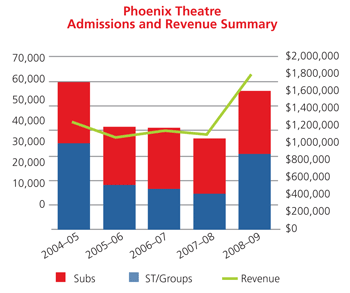59% one-year ticket revenue increase
The Scenario:
Phoenix Theatre’s ticket revenue and admissions had remained essentially flat for the three years following a big drop-off in 2005. Revenue gains in full subscription and single ticket sales were offset by decreases in group sales and flex subscriptions. The Theatre needed more substantial growth in all areas to increase revenue, which required greater patron investment.
In October 2007, TRG consultants began their work with the Company, examining a variety of issues. Key findings centered on patron retention and its effect on revenue.
Stealth patronage.
Attracting new patrons was not much of a problem for Phoenix Theatre. Getting patrons to come back was. Part of the challenge was that the Company was not consistently capturing patron information when it sold a ticket, denying Phoenix Theatre the opportunity of contacting many patrons again.
Repeat attendance.
There was no cohesive strategy for retaining single ticket buyers. In order to increase repeat attendance, Phoenix Theatre needed to seize every opportunity to encourage patrons to attend more frequently and to then convert frequent ticket buyers to a subscription.
Direct, targeted.
Phoenix Theatre needed to move toward more targeted direct marketing practices—mail, e-mail, and phone. Every season, large numbers of prospects had received “one-size-fits-all” mailings, which did not match the prospect with a customized offer. Phoenix Theatre staff believed telemarketing calls could be perceived as annoying and had never tried it.

The Results:
Over the course of two seasons in working with TRG consultants, Phoenix Theatre achieved change and the following results:
Ticket revenues increased by 59% in the 2008-2009 season.
Between 11-23% of new-to-file patrons from each show returned to another production in the 08-09 season, which was in total the highest number of new-to-file patrons to return in recent history.
How they did it:
Leveraging blockbusters.
Phoenix Theatre expected to see dramatic growth in single tickets in 2008-09 because of popular programming choices, such as
Les Miserables. TRG consultants recommended using the show’s popularity to leverage further ticket and subscription sales. Phoenix Theatre followed up with direct marketing techniques after an advance ticket purchase as well as after the show with an invitation to return. The effort paid off. That season, 30% of single ticket buyers became multi-buyers (ticket buyers who bought more than one show in the same season), up from 16% in 2007-2008. Additionally, 16% of new patrons who came to
Les Miserables came back the following season, half as new subscribers.
Investments in prospecting and retention.
Acquiring new patrons is expensive, but when paired with blockbuster programming and retention efforts, the investment pays off. TRG did a cost-of-sale analysis to right-size how much the Theatre spent on these initiatives. Consultants recommended reallocating more marketing dollars into blockbusters to focus on growth and retention. Phoenix Theatre timed its efforts strategically, investing early in season to create largest pool of prospects for cultivating towards a subscription appeal.
Maximize revenues with every patron contact.
This was Phoenix Theatre’s new top priority. Consultants encouraged Phoenix Theatre to develop its ticket office as a revenue-generating department. Training and strategic tactics included using cross- and up-selling techniques, implementing dynamic pricing, collecting patron data with a ticket purchase, and managing inventory to positively affect perception and reward subscribers. Telemarketing also fueled subscription acquisition.
About Phoenix Theatre:
Founded in 1920,
Phoenix Theatre is the one of the oldest arts organizations in the country, providing entertainment and education opportunities to Phoenix, Arizona.